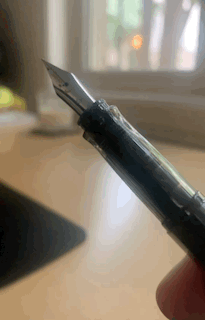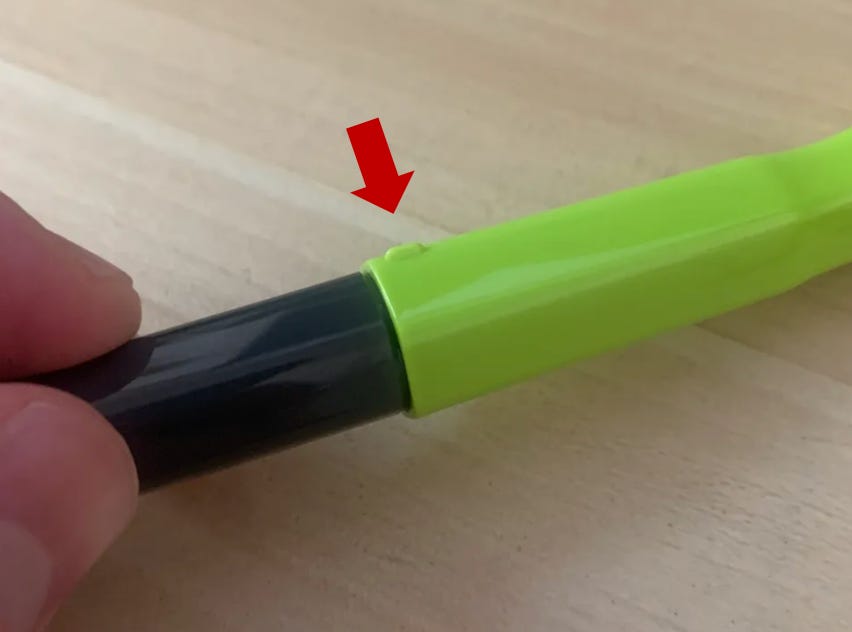This is a big dumb plastic pen.
Specifically, this is a Pilot Kakuno. It’s a pretty good exemplar of the big dumb plastic pen genre, and we’ll be focusing on it today.
Pens in this genre all share several core traits which together serve as a manufacturer’s way of telling you “hey, we don’t trust you with nice things.” For example, the cap of a big dumb plastic pen is always a snap-on, because they know you’re going to just jam the cap on there anyway.
Likewise, the grip always has these little cutouts to tell you where your fingers go, which is a helpful reminder that they go on the pen and not in your mouth.
And, of course, big dumb plastic pens are big and made of plastic so you can throw them when angry or bored or want to see a pen fly.
That said, each manufacturer’s interpretation of the big dumb plastic pen is unique. The Kakuno, for example, has a smiley face on the nib.
This is a real innovation in pen design that gives the Kakuno a competitive edge. For example, I was in a pen shop looking at fancy Sailors in a display case and debating if I wanted to spend $300-$500 to finally try out a Sailor when I saw that they also had these smiley-face pens for $16 or so1 and was like “yes, this instead.”
The Kakuno’s cap posts on the back of the pen. It doesn’t have a clip, but it does have a little tab to prevent the pen from rolling away.
Despite looking like it will accomplish nothing at all, this thing works pretty good!
Staying on the cap for a second, you will note that Pilot spells “Kakuno” with an umlaut, which at first seems like a weirdly German touch for a Japanese pen.
But this is just to make the “u” look like a smiley face, kinda like how the second “o” in Motörhead is intended to be a surprise face.2
The Kakuno uses Pilot’s proprietary ink cartridges and does not come with a converter, which is obviously lame. Plus these cartridges go in the opposite way of what you’d expect, which meant I had to read the instructions to figure out how to do it, although this affirmed I was correctly staying in my lane by buying a big dumb plastic pen. (The actual ink in the cartridge is pretty great, though, so if someone in the comments can let me know which black ink Pilot packages with these cartridges I would appreciate it as I would like to buy some.)
I got the Kakuno in a Fine and it writes extremely well. It puts down a narrow but heavily saturated line, gives pleasant feedback, and is overall a pen that writes way better than its very cheap price would indicate.
The only real negative I’d call out on this pen is that it tends to burp more ink into the cap than I’m used to, enough that it sometimes ended up on the page.
This may be because I tend to open snap-cap pens with the same barely-restrained rage as an anime villain unsheathing a sword, but still.
You can buy this pen anywhere they sell fountain pens targeted at children and adult idiots. I got this one at the Maido in San Francisco. I still own zero Sailors.
I don’t remember as I didn’t keep the receipt, but they go for $16 at Maido online.
You will never be able to unsee this now. You’re welcome!
















I love big dumb plastic fountain pens because I am a big child and I love bright colors and especially inexpensive fountain pens. Okay, I'm cheap. But, I would not trade my vintage Sheaffer No Nonsense pens for nothin' and I have quite a collection of other everyday fountain pens from different eras that would have been the Bic pens of their day. I also do enjoy the various student or beginner pens that other countries still produce a lot of because kids elsewhere learn to write with proper pens, unlike our sad chunky pencils in the US. I have a Kakuno with a medium nib and it's not bad. I still say the old Sheaffer cartridge pens (No Nonsense or others) are still the smoothest mothers out there. But I do prefer a larger nib, so that's just me.
I'm pretty sure it's just the standard Pilot Black in the cartridges.
Kaküno's are pretty great for what they are. If you ever get a hankering for the Platinum 3776 UEF nib, give the EF Kaküno a try first. It's pretty damn close in line width.